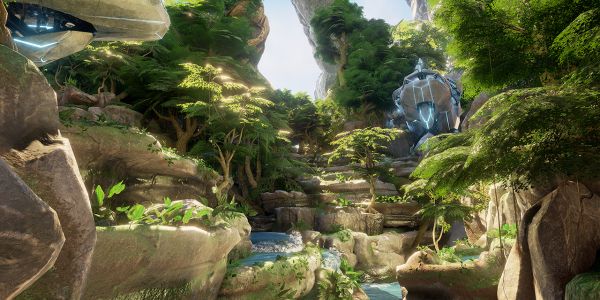Obduction Review: The Spiritual Sequel To Myst Comes To PS4

Cyan's Obduction is the spiritual sequel to Myst, one of the most popular PC games ever made. The new game has now made the leap to consoles and while the overall experience remains intact, it's not without a few bumps in the road. Obduction is everything that a fan of the classic puzzle games Myst and Riven could be looking for, but it's such a faithful recreation that it causes some of the mechanics to show their age, as well as why this sort of game is difficult to make work on a console.
For gamers of a certain age, who remember when games being produced on CDs was a new thing, Myst was almost a rite of passage. If you had a computer with e CD-ROM, back when not everybody did, this was a must-have game. Like owning a Gameboy and having Tetris.
What made Myst unique, along with its, for their time, stunning visuals, was the way the game just dropped you into the world and simply let you explore. There was little preamble or explanation. While the game had a plot, it was discovered in pieces as you moved through the world. Not only were puzzle solutions difficult to ascertain, often it wasn't even clear that what you were dealing with was a puzzle. Nothing was obvious. All you could do was wander around until you found a thread, and then pulled on it to see what would happen.
Such is the case with Obduction. One of a collection of "spiritual sequels" that found its life on Kickstarter, the new game, that includes some members of the original Myst team, has now moved over to the PlayStation 4 following its release PC.
Like its predecessor, Obduction has little in the way of setup. You start the game by following a light in the sky. Eventually, you discover a strange, alien-looking object, and the next thing you know, you've been transported to another place. It's clearly alien, landmasses float in the sky around you like something out of Avatar, yet the ground you walk on looks more like something out of the old west. Two things become immediately clear, you're not the first person to make the trip to this world, and something strange has happened to those who came before, because nobody else is around.

And that's basically it. It's up to you to figure out where you are, what's happened, and what exactly to do next. The game does a fairly good job of getting you started, nudging you in all the right directions without feeling like's it's leading you by the hand. Even when you know what it is you're supposed to do, Obduction never tells you how to do it. Sometimes the answer is obvious, sometimes not. This leads to wandering around the landscape, which is a worthy endeavor unto itself, as the game is visually stunning. You'll travel between multiple worlds which are each unique and interesting to look at. The art design for Obduction is perfect is one of the real stars of the show.
Puzzle solving is rewarding on two levels because before you actually solve the puzzle you have to find it, and recognize it as a puzzle, which isn't always easy. Everything within Obduction is connected together so no action you take goes without consequences somewhere.
CINEMABLEND NEWSLETTER
Your Daily Blend of Entertainment News
And this is part of where Obduction's slavery to its predecessors starts to wear thin. Quite often, in order to figure out how that thing you just did affected the rest of the world, and therefore, what to do next, there's little to do except start walking around and looking at everything you've seen before to see what changed. You'll be wishing for some sort of fast travel system before too long, as the only thing that gets more exhausting than crossing the map for the fiftieth time when you know where you want to go is doing it for the sixtieth time when you don't. The visuals are still lovely, but eventually, you stop seeing them as you try to simply get to where you're going as quickly as possible.
While that can be an issue regardless of which version of the game you play, the other significant problem is specific to playing Obduction on a PlayStation 4. As one can probably guess, replacing the mouse and keyboard controls with a controller is a less than perfect transition.The game gives you the ability to either leave your cursor in the middle of the screen, or unlock it to move around the screen freely. Both methods will be necessary in order to solve some puzzles, forcing you to shift the camera and the cursor around to the proper orientation again and again. Analog sticks simply aren't as precise as a mouse, which means when you're trying to activate a small button, doing so can be a pain.
I also found that some of the visuals didn't seem to translate well to a television setup. Some things, like reading simple text, vital to understanding the story of Obduction, as well as solving some puzzles, was difficult to do. Also, some very small objects that were necessary to interact with simply went by unnoticed for a long time. Even on a 70" screen, some things were hard to see due to the distance you sit back from the screen. These things are likely easier on a smaller screen where you're sitting much closer.
While these issues were frustrating, the mystery of Obduction still can't be denied. It's an immersive world even without the use of VR. Not that you have to go without VR. The PlayStation 4 version of the game includes the ability to play with PSVR and while I was not able to test that, there's little question in my mind that it's going to be the way to play the game if you have that option. Overall, Obduction is a worthy successor to the game style pioneered by Myst. The title's slow gameplay may not be for everyone, but for those that see it through, they'll be rewarded with a unique experience. Those that remember Myst will certainly enjoy an experience like this again. For those that never played it, this could be what Myst was for a previous generation.

CinemaBlend’s resident theme park junkie and amateur Disney historian, Dirk began writing for CinemaBlend as a freelancer in 2015 before joining the site full-time in 2018. He has previously held positions as a Staff Writer and Games Editor, but has more recently transformed his true passion into his job as the head of the site's Theme Park section. He has previously done freelance work for various gaming and technology sites. Prior to starting his second career as a writer he worked for 12 years in sales for various companies within the consumer electronics industry. He has a degree in political science from the University of California, Davis. Is an armchair Imagineer, Epcot Stan, Future Club 33 Member.
I've Been Skeptical Of 90 Day: Hunt For Love As A 90 Day Fiancé Fan, But Now I'm 1000% In For A Specific Reason
‘A Weird Kind Of Unintentional But Collective Cruelty.’ Ben Affleck Has A Lot Of Empathy For Britney Spears And What She’s Gone Through In The Press
Bob The Drag Queen And More Drag Race Alum Offers Messages Of Support For Jiggly Caliente After A Medical Emergency Led To Her Leg Amputation









